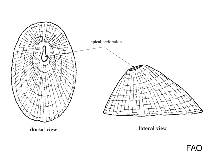Fissurella latimarginata Sowerby, 1835
| Native range | All suitable habitat | Point map | Year 2050 |

|
| This map was computer-generated and has not yet been reviewed. |
| Fissurella latimarginata AquaMaps Data sources: GBIF OBIS |
Google image | No image available for this species;
drawing shows typical species in Fissurellidae.
Classification / Names आम नाम | उपशब्द | CoL | ITIS | WoRMS
Gastropoda | Lepetellida | Fissurellidae
Environment: milieu / climate zone / गहराई सीमा / distribution range पारिस्थितिकी
; गहराई सीमा 0 - 5 m (संदर्भ 105490). Subtropical; 4°S - 41°S, 82°W - 68°W
Distribution देश | ऐफ ऐ ओ क्षेत्र | Ecosystems | संयोग | भूमिका
Southeast Pacific: from Chiclayo (Peru) to Rio Bio-bio (Chile).
Length at first maturity / आकार / Weight / Age
परिपक्व अवधि: Lm ? range ? - ? cm
Life cycle and mating behavior परिपक्व अवधि | पुनरुत्पत्ति | मछलीऔ का अंडे देना | Eggs | Fecundity | Larvae
Main reference
संदर्भ | संयोजक | सहयोगीयो
Servicio Nacional de Pesca y Acuicultura. 2011 Nomina de Especies. http://www.sernapesca.cl/index.php?option=com_remository&Itemid=47&func=startdown&id=5055 [Accessed 28 May 2012]. (संदर्भ 90098)
IUCN Red List Status
(संदर्भ 130435: Version 2025-1)
CITES status (संदर्भ 108899)
CMS (संदर्भ 116361)
Threat to humans
Human uses
मात्स्यिकी: व्यापारिक
| FishSource |
साधन
अधिक जानकारी
संघटक आहार
आहार खपत
परभक्षी
इंटरनेट स्रोत
BHL | BOLD Systems | CISTI | DiscoverLife | FAO(Publication : search) | Fishipedia | GenBank (genome, nucleotide) | GloBI | Gomexsi | Google Books | Google Scholar | Google | PubMed | Tree of Life | Wikipedia (Go, खोज) | Zoological Record



